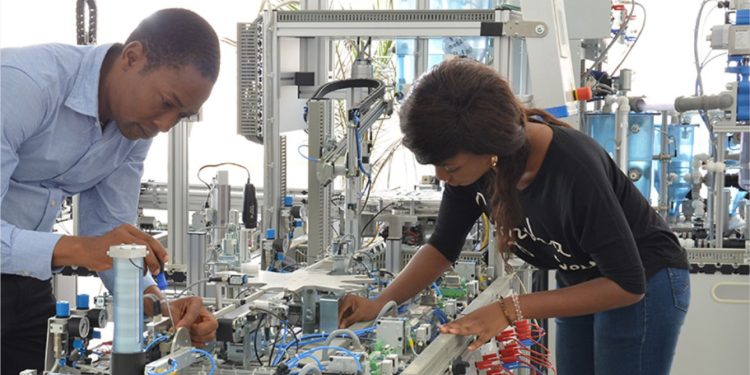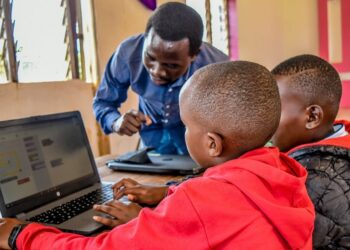The COVID-19 pandemic has brought to the fore the challenge of delivering practical lessons remotely, especially in Africa. This is mainly due to technological and resource limitations in addition to inadequate educator and trainer capacity to deliver such online lessons. The time is ripe to critically look at the role of digitalization of technical and vocational education and training (TVET) if we are to better prepare and equip Africa’s youth for the future of work. Digital skills have become vital in a world of increasing adaptability skills. It is now up to the policymakers to embrace this new normal and reform education policies accordingly.
Technical and Vocational Education and Training has been instrumental for the economic development and industrialization of societies all over the world. Numerous examples abound, from European countries throughout the 18th century’s industrial revolution, Japan at the end of 19th century’s Meiji dynasty and ASEAN countries during the 20th century globalisation would stand for proof of social progress with the rise of the labour market and the TVET demand-driven in each society. How could we capitalise on this to continue our social progress worldwide?
What makes TVET successful is the focus on skills development, that is, using hands-on training. This helps students and future job seekers to acquire not only the essential knowledge on the subject matter but also the required competences that one would need to fulfil employers and economic stakeholders’ expectations. Skills change lives, by offering everyone a future for professional occupations and entrepreneurship.
Access to TVET remains one of the most onerous sectors of education systems worldwide. Countries struggle to finance the establishment of TVET schools as social benefactors, to support the sustainable development of their labour markets and economies. Access to laboratories and workshops requires important and upfront investments, very often not available in the national education annual budget allocation. The question would be if Education Technologies – EdTech would be a driver for developing alternative methods for the hands-on training in TVET.
Would digital learning and training help us to reduce investment-unit to enrol a maximum number of students in an education system? Whether digitization would offer facilities to provide more meaningful TVET activities, transforming the mode of delivery from on-site attendance, now indispensable for hands-on training, to on-line interaction, without losing sight of the virtue of “learning-by-doing”? Because of the lack of budget, or because of the COVID-19 global pandemic placing millions of students out of school, it becomes equally important to increasingly consider new modes of digital delivery in TVET systems, to be coined worldwide as Digital Technical and Vocational Education and Training (D-TVET).
The recent progress of EdTech, beginning with the use of digital education tools, like computers or web-based trainings, online and offline learning management systems from the early ‘90s, up to individual adaptive learning, use of Artificial Intelligence (AI), Virtual Reality (VR) and Augmented Reality (AR) in simulated and remote laboratories nowadays, is helping us to provide meaningful D-TVET solutions to overcome challenges. This helps us in providing more on-line students with quality education with less on-site students in classrooms, whether this be due to lack of budget or the necessary social distancing.
Such changeover of TVET models would have an impact on students, teachers, and schools alike. On (i) students, on how they would learn with more “off-the-school” and “near-the-school” learning scenarios, on (ii) teachers, on how they would teach the subject matter, changing and alternatively adapting the new-pedagogy, as well as on (iii) schools that should accommodate students and teachers in a new way of interacting with each other for learning and teaching, probably with no less important impact that this will have on the efficient education budgeting in this new era.
More conventional modes of delivery such as the “on-the-school” presence of students could be optimised by intermittent scenarios for learning in communities, setting the stage for boot-camp-style laboratories for shorter and more intensive hands-on training.
New opportunities are being offered to reimagine the 21st century school as a social venue for education to be more accessible, more relevant, more resilient and by also leaving no one behind.
D-TVET with necessary access to ICT infrastructure and internet should provide new prospects to boost education for all, as a life-long learning for initial and continuing education, skilling, reskilling and up-skilling individuals, providing them job opportunities and socioeconomic prosperity. This will be valid everywhere, in particular in Africa, our beloved continent.















































































 EduTimes Africa, a product of Education Times Africa, is a magazine publication that aims to lend its support to close the yawning gap in Africa's educational development.
EduTimes Africa, a product of Education Times Africa, is a magazine publication that aims to lend its support to close the yawning gap in Africa's educational development.

